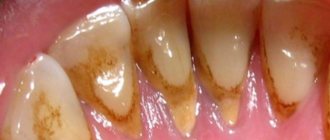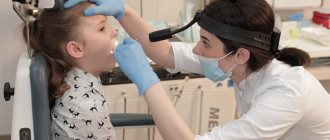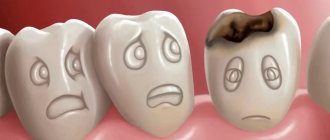There are three types of leukoplakia, which are sequential forms of development of the same disease:
- flat leukoplakia - looks like a whitish film that cannot be removed mechanically. Depending on the location and duration of the disease, the color can vary from white to dirty gray. The surface of the lesion is dry and rough; slight redness of the integument may develop along the perimeter;
- verrucous leukoplakia - develops at the next stage and looks like whitish plaques or warty growths. This stage of the disease is precancerous - without proper treatment, the tumor may degenerate into malignant;
- erosive leukoplakia is characterized by ulcers and cracks that appear against the background of one of the two previous stages of the disease. Of the three stages, only at this stage does the patient experience pain.
Hairy leukoplakia of the mouth or tongue - symptoms and treatment
Content:
What is oral leukoplakia
Causes of leukoplakia in the oral cavity
Symptoms of hairy leukoplakia
What does hairy leukoplakia look like?
What are the dangers of leukoplakia?
How to treat hairy leukoplakia
Various diseases occur on the oral mucosa, which are a manifestation of reduced immunity. A common condition is hairy leukoplakia of the tongue.
Reasons for development
The main cause of leukoplakia of the tongue is considered to be the presence of the Einstein-Barr virus in the human body; it is the most common on the planet (at least 95% of the entire population has suffered from the diseases caused by the virus). The agent is transmitted mainly through biological fluids, often through saliva.
No wonder the main pathology it causes, infectious mononucleosis, is called the kissing disease. However, this disease most often affects children and adolescents, while adult patients develop immunity to mononuclear infection by the age of 25.
If a person’s immunity is not reduced, and infection with the Epstein-Barr virus does occur, leukoplakia can be practically asymptomatic, but associated diseases often develop against the background of this pathology. These include lymphogranulomatosis (a malignant lesion of lymphoid tissue) and Burkitt's lymphoma (the hematopoietic system is affected here, and the disease has an extremely unfavorable prognosis).
In addition to the fact that hairy leukoplakia is diagnosed in almost all patients with HIV infection, the following factors can lead to its development:
White coating on the root of the tongue
- abuse of tobacco products;
- tongue cancer;
- blood diseases, such as leukemia;
- regular negative effects on the oral mucosa of ultraviolet rays;
- deficiency of vitamins B and A in the body;
- constant irritation and injury to the soft tissues of the gums, lips, cheeks and tongue due to crooked teeth, crowns, bridges, incorrectly installed braces and dentures;
- autoimmune diseases - HIV, AIDS, rheumatoid arthritis, diabetes;
- hormonal imbalances;
- long-term use of medications that strongly suppress the immune system.
When the Epstein-Barr virus enters the body, especially if the patient is over 45 years old, tends to smoke and has chronic diseases, the immune system becomes defenseless, which leads to active replication of the enemy agent. In such situations, the manifestations of hairy leukoplakia will be striking and will force the patient to urgently consult a doctor.
Pathology can be caused by several types of viruses
What is oral leukoplakia
Leukoplakia is a lesion of the oral mucosa in which excessive keratinization is observed. Located on the cheeks, hard and soft palates, and tongue.
Types of leukoplakia:
- Flat is the most common form. Usually does not cause discomfort. Discovered by chance at a dental appointment.
- Verrucous - more pronounced keratinization than with the flat form. Patients note a feeling of roughness and tightness on the mucous membrane, a burning sensation.
- Erosive – is a complication of the previous two forms when exposed to a traumatic factor. Characterized by pain. which occurs when talking or eating.
- Hairy leukoplakia is a disease caused by the Epstein-Barr virus. Often observed in patients with HIV.
- Tappeiner's leukoplakia - it is found in long-term smokers. It is observed on the soft and hard palate.
Some forms of this disease are considered precancerous. If left untreated, they develop into malignant tumors. Therefore, it is important to contact a dental clinic in Moscow when you first detect pathological changes in the mucous membrane.
Hairy leukoplakia (HL) was first described in 1984 by D. Grinshpan et al. in homosexuals suffering from AIDS [1]. It is a benign proliferation of epithelial cells of the oral mucosa (OMC) without a tendency to malignant degeneration [2−6]. Caused by active replication of the ubiquitous Epstein-Barr virus (EBV) [2,4,7−9]. The reservoir of the virus and the source of infection is an infected person with or without clinical manifestations [7,9]. The transmission routes are varied: airborne; contact, in which virus-rich saliva plays a significant role (during kissing, through toys and household items); sexual; blood transfusion; intrapartum. The possibility of transplacental transmission is possible. The virus was isolated by Michael Epstein and Ivonne Barr in 1964 from Burkitt's lymphoma cells and was named in honor of its discoverers.
In 1979, EBV was assigned to the herpes family (herpesvirus type 4), and in 2016 to its subfamily - gammaherpesviruses (human gammaherpesvirus-4). In the literature, the original name is more often used - “Epstein-Barr virus”.
EBV selectively infects B lymphocytes and epithelial cells. The cells affected by it do not undergo lysis, but active proliferation. After infection with EBV, the infection it causes in all age groups occurs either in a clinical form in the form of infectious mononucleosis, or in a latent form, i.e., without clinical manifestations. Susceptibility to the virus is high, but the contagiousness of infectious mononucleosis is low: EBV infection occurs mainly latently.
Infectious mononucleosis is characterized by the following clinical manifestations [7,9]: fever, damage to the tonsils, polyadenitis with a predominance in the posterior cervical region and sometimes hepatosplenomegaly, and in adults - additional yellowness of the sclera, mucous membranes and skin. Often, infectious mononucleosis is accompanied by macular and papular rashes, which spontaneously and completely disappear 2-3 days after their appearance. Laboratory confirmation is leukocytosis, in which the number of large mononuclear cells exceeds 10%, sometimes reaching 80−90%. It has been established and generally accepted that a similar symptom complex can be caused by other viruses, in particular HIV.
Most often, infectious mononucleosis is reported in adolescents, rarely in children, and only rarely in adults. The latent form is more characteristic of adults: with very rare mononucleosis, antibodies to EBV are detected in the vast majority of adults. In the latent form, EBV remains in an inactive state in B lymphocytes [6,10].
In HIV-infected people and especially in AIDS patients, EBV, which was in an inactive state, is reactivated, i.e., acquires active properties, thus becoming a pathogen. Now it causes the development of VL, which affects the oral mucosa, and, as a result of its active effect on cell proliferation, takes part in the pathogenesis of large B-cell lymphoma and Burkitt's lymphoma. In addition, EBV can accelerate the progression of HIV infection by enhancing the growth of HIV in lymphocytes [6].
Below we present ideas about VL according to our observations and available publications.
Initially, VL manifests itself as slightly protruding small papules of white color, rounded in outline and with clear boundaries, resulting from EBV infection of epithelial cells of the oral mucosa. Outwardly they look like hair. Papules are most often located on the lateral (one or both) sides of the tongue. Their number is variable - from single to multiple. Early manifestations of VL, in addition to papules, are considered to be corrugations (strands) vertically located on the lateral sides of the tongue (Fig. 1)
Rice. 1. Early manifestations of VL (strands). *. Later, the strands increase in size and number, fit tightly to each other, forming corrugated plaques (Fig. 2).
Rice. 2. Corrugated plaques with VL. The color of the plaques is white, the boundaries are clear. Over time, their white color darkens to gray, the boundaries become fuzzy and blurred. With both plaques and cords, papular rashes are detected perifocally.
The lateral sides of the tongue are a typical location for VL, but sometimes it can be the dorsum of the tongue (Fig. 3)
Rice. 3. VL on the back of the tongue. and its lower surface, the buccal mucosa, soft and hard palate (Fig. 4),
Rice. 4. VL in the area of the hard palate. floor of the mouth and pharynx. VL usually does not cause subjective concerns; occasionally patients complain of mild pain, burning and difficulty swallowing. It cannot be scraped off: only the cells of the surface layers are removed. Antimycotic treatment of VL in some cases causes some improvement due to the suppression of candidal complications.
VL oral mucosa is considered one of the most specific manifestations of infection caused by HIV [6,11,12]: it is detected mainly in HIV-infected people and patients with AIDS. Mainly, but not exclusively. In rare observations, VL was also detected in other categories of patients with immunosuppression, in particular in recipients of internal and other organs, and even in healthy individuals [2,6].
Against the background of HIV infection, VL usually occurs in adults, rarely in adolescents and children; not described in infants. It is formed at any level of the number of CD4 helper cells. Its complete formation occurs when the number of CD4 helper cells is below 200 in 1 mm3 of blood, i.e., with AIDS [2,6,13].
VL indicates the progression of HIV infection, is a reliable clinical marker of its later stages and AIDS, and also serves as an early harbinger of the tragic outcome of the underlying infection.
Features of VL in HIV infection include gum damage (Fig. 5),
Rice. 5. Gum damage due to VL in an HIV-infected patient. often with clinical manifestations occurring as ulcerative necrotic gingivitis (Fig. 6).
Rice. 6. VL of the type of necrotizing ulcerative gingivitis in an HIV-infected patient.
Candida are sometimes found in VL foci
. This circumstance underlies the not so rare diagnostic errors: VL is mistaken for candidiasis and vice versa [14]. However, the structures of these two oral diseases are different. VL is manifested by thickening of the mucous membrane in the form of papules, strands and plaques due to the proliferation of its cells, and with oral candidiasis - a mycotic plaque on this membrane [15]. Therefore, scraping does not remove the clinical manifestations of VL, but it does remove the clinical manifestations of oral candidiasis.
Pathohistological manifestations of VL are reduced to hyperkeratosis, parakeratosis and acanthosis, as well as hair-like projections of keratin on the surface of the epithelium. If it is necessary to confirm the clinical diagnosis of VL, it is better to resort not to histological examination, but to the in situ
. It is superior in reliability to histological examination, and most importantly, it is quite acceptable when examining a sick person. Using this method, EBV DNA is detected in scrapings from VL lesions, which allows it to be considered highly specific.
As for the “hairs” of leukoplakia, by assumption they are filiform papillae of the tongue infected with EBV. The following facts provide indirect evidence of this assumption. The filiform papillae of the tongue are up to 1.5 mm long and up to 0.6 mm wide. They densely (up to 500 per 1 cm2) dot its lateral surfaces [16]. “Hair” is described in a typical localization of leukoplakia. Its atypical (rare) localizations, where filiform papillae are absent, are only listed. Only Emond, Welsby and Rowland, in their Atlas, which went through 4 editions from 1974 to 2003, note that the surface of VL foci in its atypical localizations is even and smooth, i.e., devoid of “hair” [17,18].
In conclusion, we note that, according to the observation of Kreuter A. and Wieland U. [19], VL may be the first and only manifestation of HIV infection in individuals without any abnormalities in general health and well-being. Therefore, in such cases, VL serves as an indication for testing for HIV infection.
Information about authors
Potekaev N.S. — https://orcid.org/0000-0001-8036-0011
Potekaev S.N - https://orcid.org/0000-0001-6643-2023
Potekaev N.N. — https://orcid.org/0000-0002-9331-7714
Zhukova O.V. — https://orcid.org/0000-0001-5723-6573
Illustrations provided by the head. Department of diseases of the oral mucosa of the Central Research Institute of Infrastructure and Maxillofacial Surgery, prof. O.F. Rabinovich.
Causes of leukoplakia in the oral cavity
To date, scientists have not reached a consensus on why the disease occurs. There are factors that can lead to the development of excess keratinization:
- Constant exposure to irritating factors: smoking, regular burns from hot food, strong alcohol, etc.
- Work in industries where there are chemicals, alkalis, acids.
- Living in a hot, dry climate.
- Taking drugs that reduce immunity.
- Local traumatic factors: failed fillings, sharp edges of dentures and damaged teeth, poor-quality braces.
- Endocrine pathologies: diabetes mellitus, hyperthyroidism, hypothyroidism.
- Reduced immunity: HIV, AIDS, immunosuppressive state. Oral hairy leukoplakia is often observed in patients with HIV and AIDS.
Treatment and prevention of the disease
If you find any manifestations that resemble leukoplakia, you should immediately consult a doctor! Since this disease is a type of precancerous condition, it is critically important to identify it in time and carry out a set of treatment measures. One of the important reasons for timely treatment of leukoplakia is the fact that more than thirty percent of cancer patients diagnosed with squamous cell carcinoma of the tongue and oral mucosa were previously diagnosed with oral leukoplakia. Often, as a result of histological analysis of leukoplakic plaques, it turns out that the patient has cancer.
Treatment of leukoplakia must be comprehensive. The dentist must clean the oral cavity (sanitation), as well as identify and eliminate traumatic factors - fragments of teeth, uneven edges of fillings and crowns. The patient, in turn, must be aware of the importance of giving up alcohol and smoking in the early stages of treatment. Most likely, incorrectly installed dentures and fillings will be removed. It is also necessary to avoid spicy and solid foods.
The patient will have to undergo studies to identify possible somatic diseases that accompany leukoplakia in most cases. Thus, you should prepare for an appointment not only with a dentist, but also with an endocrinologist, therapist and, first of all, with an oncologist.
How to treat hairy leukoplakia
Before starting treatment, you need to conduct a number of studies. The patient is referred to a therapist at the clinic. There, the doctor can prescribe laboratory tests: biochemical blood test, testing for sexually transmitted diseases, etc.
If a person is diagnosed with HIV infection, antiretroviral therapy is administered. With long-term use of drugs, the patient’s well-being improves, and the disease in the mouth goes away.
The dental clinic provides oral examinations, dental diagnostics, and professional hygiene. If sharp edges of fillings or failed prostheses are detected, they are replaced. Treatment of caries and its complications is carried out. Recommendations are given for home dental care: personal hygiene products (brushes, pastes, dental floss, rinses) are selected.
Keratolytic drugs are suitable for local treatment. In advanced cases, they resort to surgical manipulations: excision of the affected areas with a laser.
Symptoms
Signs of hairy leukoplakia usually appear gradually and do not have an acute, pronounced character. First, the patient notices the appearance of small folds along the lateral edges of the tongue, which are whitish in color and resemble the surface of a washboard. To the touch, the affected areas differ from healthy mucous tissue; they are rougher and rougher.
If at this stage a person does not seek help from a doctor and does not receive the necessary treatment, then the atypical formations on the sides of the tongue begin to merge into larger areas of lesions, taking on the appearance of plaques without a clear outline. These formations do not cause the patient discomfort, pain, burning or itching, in addition to a pronounced cosmetic defect. Unpleasant sensations may appear when palpating the affected areas of the mucous membrane or when eating too hot or cold food.
In most cases, areas of keratinized tissue on the tongue are located symmetrically, for example, on both sides; less often, the pathological process spreads to the soft palate and the inner sides of both cheeks. This is due to the fact that the patient can for a long time attribute the appearance of fleecy formations to mechanical injuries to the mouth, poor hygiene and other factors.
As a consequence, the disease develops into a rather complex form, fraught with the development of malignant cells in the layer of mucous epithelium. At this stage, especially if areas of rough skin are located at the base of the tongue, the patient may suffer from bouts of dry cough and sore throat, and it becomes difficult for him to speak.
Characteristic signs of hairy leukoplakia, which are detected during microscopic examination of mucous tissue:
- acanthosis - the so-called thickening of the spinous layer of tissue, is observed due to the accelerated division of keratinocytes. These histological changes are also diagnosed in eczema, lichen planus and other skin pathologies;
- hyperkeratosis - a significant thickening of the epithelial layer, which is considered the result of increased formation of keratin in cells, while growths are observed on the surface of the epithelium;
- symptoms of viral damage to mucous tissue - microscopic examination reveals an increase in cell nuclei and perinuclear rims, which directly indicates the presence of the Epstein-Barr virus or papillomavirus.
When examining smears from the oral cavity, doctors almost always find a fungal infection in them, but it is not the cause of hairy leukoplakia; rather, it is a sign of a severe decrease in immunity
Symptoms of infection do not disappear even after a course of antifungal drugs, and taking these drugs does not in any way affect the course of leukoplakia.
Types of pathology:
- Simple leukoplakia - the affected areas are flat, acquire a whitish color, plaque cannot be removed from the surface of the tongue with a cotton swab or toothbrush.
- Verrucous - spots formed on the epithelial layer are covered with warts or plaques.
- Erosive-ulcerative is a more complex form of pathology than the previous two. Ulcers and cracks appear on the rough surface of the mucosa, causing severe discomfort to the patient.
These forms of the disease can occur in isolation or follow one after another, in the absence of the necessary treatment. The latter, ulcerative-erosive form, can provoke the process to become malignant, so the patient should prevent such disastrous consequences and seek help from a doctor in time.
Treatment methods for leukoplakia
Despite the fact that leukoplakia should not be treated, the patient should still take a number of measures that can help get rid of the disease as quickly as possible. If the disease could be caused by trauma to the oral cavity, bite correction, dentures, or uneven edges of the teeth should be corrected. In case of leukoplakia, smoking should be limited or (preferably) completely abandoned. If the doctor has diagnosed the presence of systemic diseases, be sure to direct all efforts to cure them. In mild forms, you should restore damaged tissues using rosehip oil, sea buckthorn and take vitamin A.
Treatment of leukoplakia in a specialized clinic usually involves surgery, but another effective method can be cryodestruction (freezing out pathological formations with liquid nitrogen), subsequent chemotherapy and the use of anti-tumor drugs.
The staff of the AlfaDent dental clinic in Orenburg are ready to provide professional medical assistance in restoring oral health and getting rid of leukoplakia at any age.
"AlfaDent" is a professional approach to complex tasks.
Clinic
The incubation period for HIV infection is 1–3 months, but can be longer. After this, the initial stage of the disease develops, called acute HIV infection.
Only 20% of infected people develop clinical signs in the form of a general infectious syndrome of an undifferentiated nature (mononucleosis-like manifestations, serous meningitis, encephalopathy, myelopathy or neuropathy).
A clinically favorable outcome of the acute stage of the disease does not mean either the acquisition of immunity or recovery, despite seroconversion. The disease progresses to a chronic stage, which occurs either subclinically or in the form of persistent generalized lymphadenopathy with a constant subtle transition to the AIDS-associated syndrome.
Patients remain active, productive and in good health. There are no signs of immunosuppression yet.
Prognostically unfavorable is a decrease in the size of the lymph nodes, which means involution of the follicles - a morphological sign of immunosuppression.
Clinical symptoms of the AIDS-associated stage of the disease consist of signs of initial immune deficiency. They are manifested by local infections of the skin and mucous membranes caused by low-pathogenic representatives of microflora of an opportunistic nature (viral and bacterial stomatitis, pharyngitis, sinusitis, oral, genital, perianal herpes, recurrent herpes zoster, candidal stomatitis, genital and perianal candidiasis, dermatomycosis of the feet, legs, impetigo , acne folliculitis, hairy leukoplakia of the tongue, etc.).
Lesions of the skin and mucous membranes are initially easily amenable to conventional therapy, but quickly recur and gradually become chronically recurrent in nature. The most important feature of the clinical picture of the AIDS-associated complex is the steady increase in symptoms with the worsening of existing lesions and the appearance of new lesions.
The chronic stage of the disease gradually moves into its final stage - AIDS. By this time, immune functions are suppressed and disturbed to the maximum (CD-4 lymphocytes are reduced to 100 per 1 mm3).
According to available observations, 5 years after infection, from 25 to 50% of people develop AIDS, after 7 years - up to 75%, after 10 years (observations since 1981) - slightly more than 90% of those infected. Can the remaining 10% not get sick? They can if the latent period of the disease turns out to be longer than the remaining years of their life.
Infections - the most common and dangerous manifestation of AIDS - develop in the form of localized, generalized and septic forms. The skin, mucous membranes, and internal organs are affected.
The clinical features of infectious processes in AIDS are their increasing nature, prevalence, severity, atypical symptoms and multiplicity of localizations.
The main diseases that manifest themselves in AIDS on the oral mucosa, depending on the etiotropic factor, are grouped as follows.
1. Fungal infections:
- candidiasis (pseudomembranous, erythematous, hyperplastic - in the form of a plaque or nodes, angular cheilitis);
- histoplasmosis.
2. Bacterial infections:
- fusospirochetosis (ulcerative-necrotizing gingivitis);
- nonspecific infections (chronic periodontitis);
- mycobacteria, enterobacteria.
3. Viral infections:
- herpetic stomatitis;
- hairy leukoplakia;
- herpes zoster (shingles);
- xerostomia caused by cytomegalovirus.
4. Neoplasms:
- Kaposi's sarcoma in the oral cavity;
- squamous cell carcinoma;
- Non-Hodgkins lymphoma.
5. Lesions of unknown etiology:
- recurrent ulcerating aphthae;
- idiopathic thrombocytopetic purpura (ecchymoses);
- lesions of the salivary glands.
Symptoms of HIV infection in the oral cavity
The herpes simplex virus is present in most people. The infection persists in the body throughout life and does not cause any special problems, except for rare rashes on the lips.
Herpetic gingivostomatitis
In HIV-infected people, herpes rashes are chronic with rare stages of remission. It is distinguished by blistering rashes around the mouth and on mucous tissues. When the vesicles open, painful erosions occur that develop into fairly large ulcers. The manifestation of herpes zoster and rashes in atypical places is also noticed.
Candidiasis
Candidiasis is also a common symptom of HIV infection and is chronic. Its symptoms are the same as with regular thrush, the only difference being that plaque covers most of the mouth.
Hairy leukoplakia
Clinical manifestations of the disease look like deformed mucous tissue, externally resembling folds or hairs. Localization area: lateral parts of the tongue and the inner surface of the cheeks. Painful sensations are usually absent.
HIV gingivitis and periodontitis
In this case, the infection manifests itself as acute inflammation of the gums. Starting with ordinary bleeding gums, the disease quickly develops into an acute form. With adequate treatment, tooth loss can be avoided.
Kaposi's sarcoma
This is one of the most characteristic symptoms of HIV infection in the clinical stage of manifestation. The tumor is formed from lymphatic vessels, in the mouth it is located near the root of the tongue, less often on the gums.
Causes of oral leukoplakia
The causes of oral leukoplakia remain unclear. However, certain events are associated with its appearance:
- Excessive and prolonged use of tobacco (smoking or chewing).
- Abrasions from rough teeth or ill-fitting dentures, fillings or crowns, and from chewing areca nut and betel leaf.
- Viral infections such as HIV or AIDS.
- Deficiency of vitamins A, B12, C and folic acid in the blood.
- Endocrine disorders
- Sun exposure
Although tobacco is considered a major factor in oral leukoplakia, none of its individual biochemical components have been isolated as the sole irritant that could cause these lesions. Men are twice as likely to develop oral leukoplakia as women.
Leukoplakia patches in the mouth resemble thrush, which usually appears in the mouth of patients suffering from diabetes, HIV or cancer due to the accumulation of fungus (candida). Thrush, like hairy leukoplakia, indicates a weak immune system, optimal for viral infections. Unlike oral leukoplakia lesions, thrush presents as creamy, painful patches that bleed when scraped.
Most oral leukoplakia lesions are of unknown origin (idiopathic). Areas of idiopathic oral leukoplakia are considered precursors to oral cancer (precancerous lesions) and require regular examination (biopsy) every 2–3 months. Excessive tobacco and alcohol consumption are important risk factors associated with the transformation of oral leukoplakia into malignant tumors. Oral leukoplakia accounts for 20% of the total number of detected oral cancers.










